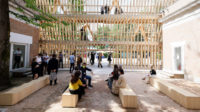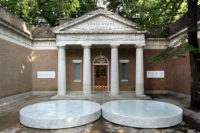The phrase Everlasting Plastics evokes images of bottles floating in the Great Pacific Garbage Patch, or micro particles in human blood. It’s also the name of the exhibition planned for the United States Pavilion at the Venice Architecture Biennale that will run from May 20 to November 26, 2023. Curators Tizziana Baldenebro and Lauren Leving plan to fill the pavilion with works in plastic by two architecture professors, two designers and a sculptor in order, Baldenebro says, to examine plastic “both literally and as a cultural metaphor.”
The U.S. State Department’s Bureau of Educational and Cultural Affairs, with guidance from a committee of the National Endowment for the Arts, selected Cleveland’s non-profit gallery SPACES, where Baldenebro is executive director, as the pavilion’s commissioner. Leving, a curator at the Museum of Contemporary Art Cleveland, collaborated on the proposal. She and Baldenebro both had links to the 2018 U.S. exhibition in Venice: Baldenebro was a student exhibitor at one of the pavilion’s “partner programs” while Leving, formerly exhibitions manager for Chicago’s Wrightwood 659, helped bring the 2018 show to that museum. They say they were as surprised as anyone when they were selected.
Though it is too soon for the curators to say exactly what the pavilion will contain, they have commissioned work from Xavi Laida Aguirre, who teaches at MIT and runs the design practice stock-a-studio; Ang Li, assistant professor at the School of Architecture at Northeastern University and a practicing architect; designers Norman Teague of Chicago and Simon Anton of Detroit; and Cleveland-based sculptor Lauren Yeager
In a phone interview, both curators stressed the significance of plastic to Ohio, where the petroleum-based polymers are an important industry, and they talked about lifesaving uses of plastic. Yet the exhibition is likely to focus on the negative. “We are very critical of plastic as a one-time-use material,” Leving said, explaining that they are exploring ways plastic can be part of a circular economy. After all, she said, “Even if we stopped producing plastic there’s a lot of it in the world. What we can do with it is one of the issues we’re looking at.”
Asked whether there will be more conceptual art than architecture—a trend at recent Biennales—Leving said she expected the participants to use plastic “to manipulate space in a way that resonates emotionally and intellectually.”
Baldenebro added, “There will be architecture with a capital A. But I’m very much in favor of the lines between architecture and art blurring more than they have in recent years.”
The curators have taken on an additional issue: the limitations of exhibiting in the neoclassical U.S. pavilion in Venice. Going to the Biennale is for the privileged and the able-bodied (since the trip can be expensive and the city hard to navigate). “We can’t redesign the entire city of Venice,” Leving said, “so we are thinking of ways to make the exhibit available in the U.S.” That includes finding stateside venues for the show after the Biennale closes, as well as allowing people to participate online. “We’re placing accessibility at the forefront,” she said.
The 18th International Architecture Exhibition of La Biennale di Venezia: The Laboratory of the Future (May 20–November 26, 2023) is directed by Lesley Lokko and presents new ideas and projects from around the world.




Post a comment to this article
Report Abusive Comment